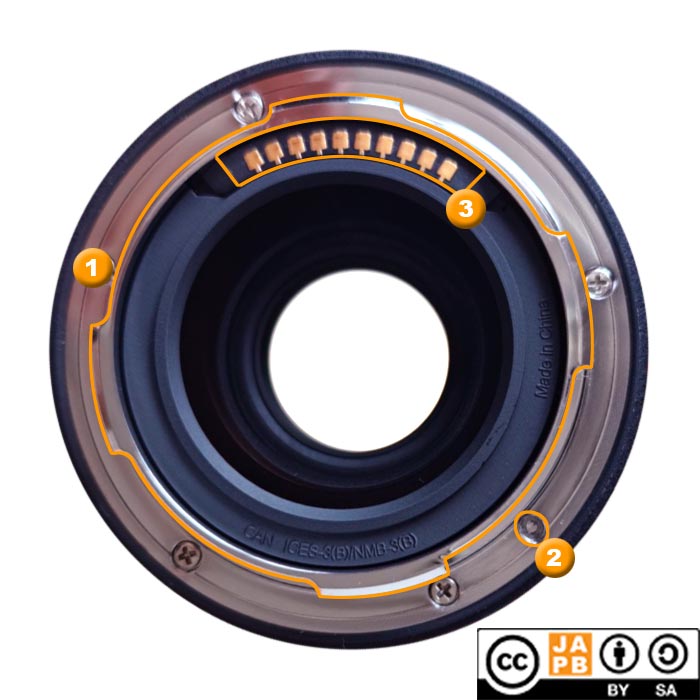Pekka Buttler (Updated 5/2025)
Leica L mount specifications and identification
Mount type: Bayonet mount (four prongs, lens release on camera)
Flange focal distance: 20,00 mm
Sensor sizes:
• 36mm x 24mm (‘Full frame’, SL)
• 23,6mm x 15,7mm (APS-C, TL)
Mount communication:
• 10 electronic contacts (spring-loaded at camera-end)
• no mechanical communication

Key characteristics of L mount:
[1] Four-pronged male bayonet.
[2] Locking groove at 04:30
[3] 10 electronic contacts (spring-loaded at the camera-end) between 11:00 and 01:00.
Basic Information on the (Leica) L mount:
The L mount is a modern lens mount for mirrorless interchangeable lens cameras.
It has its origin in the lens mount Leica used in its Leica T (APS-C sensor MILC) camera in 2014, at which time Leica referred to it as the T-mount. When Leica in 2015 introduced the Leica SL (full-frame sensor MILC) it used the same mount. The mount was renamed to the Leica L mount and the Leica T camera was renamed the TL.
In 2018 Leica, together with Sigma and Panasonic formed the L mount alliance which is a co-licensing agreement for sharing the technology and specifications of what used to be the Leica L mount. While it is still at times referred to as the “Leica L mount”, official marketing material refers to simply as the “L mount”.
Technically, there are two versions of the L mount: A full-frame version (a.k.a. the SL mount) and an APS-C version (a.k.a. the TL mount), but both are physically and electronically compatible and SL lenses can be used without limitations on TL bodies, while TL lenses may not cover the entire full-frame sensor on SL bodies.
Compared to other MILC mounts (Sony E/FE; Nikon Z; Canon RF, Fujifilm X, etc.) that are clearly proprietary and the property of a single corporation, the L-mount is currently the result of an alliance, and while the full specifications of the L mount are not publicly shared, the L mount alliance proclaims that the L mount is a ‘Universal mount’ and that any company that becomes a full member will be able to produce 100% L mount compatible gear. However, as the current participants of the alliance (Leica, Sigma, Panasonic, DJII) are unique in having little if any overlap, I wonder how the alliance would view a ‘membership’ application from, say, Tamron, or Pentax, or Canon …
Personally, I would like nothing more than a return to the age of universal mounts (let products compete on their own merits, instead on the merits and lock-in of closed ecosystems…), but … let’s just say that given the track record of some of the alliance’s key actors, I have my doubts about whether this is an honest attempt to create a shared, ‘universal’ mount.
Adapting to L Mount bodies
Being modern mirrorless full frame cameras, there are only very few limitations on what can be adapted to L mount cameras.
That said, there are a number of considerations:
• If the lens is dependent on electronic communications, a suitable smart adapter must be available. Such adapters exist for Canon EF lenses, but I have not yet found smart adapters to use with other dSLR lenses that necessitate electronic communication. Whether the future will see the introduction of – say – smart adapters for Sony A / Minolta A or Mamiya Z mount lenses is anyone’s guess.
• Adapter availability. While the L mount has been around for some years, that is not enough to guarantee a wide availability of adapters.
• Being among the longer full-frame mirrorless lens mounts, there are a number of systems that will remain challenging for the L mount system (Especially Sony FE and Nikon Z).
• L mount cameras do not natively support smaller capture areas than APS-C, so it would make things more straightforward (less hassle in post) if the lens was able to project at least an APS-C image circle. Many of those lenses designed for film formats smaller than APS-C (including Pentax-110, C-mount, Olympus PEN-F) regularly cover the APS-C sensor (some even make a good try of full-frame), but this is by no means a given. Hence, it becomes a lens-to-lens question instead of a strictly mount-related issue.
Adapting L mount lenses
L mount lenses have a rather short flange focal distance, meaning that the list of systems theoretically (optically) able to utilise Canon RF lenses is very short (Fujifilm X, Hasselblad XCD, Nikon Z, Sony FE,).
Moreover, as the typical L mount lens is highly dependant on the lenses being able to communicate electronically, any adapter would need to be a smart adapter to not entirely cripple the lenses. Currently it seems no such adapters yet exist, making electronic L mount lenses usable only onL mount cameras.
However, there are also some manual (non-electronic) lenses native to the L mount and there are no electronic limitations on being able to adapt such lenses to any lens mount with a shorter flange focal distance (Fujifilm X, Hasselblad XCD, Nikon Z, Sony FE) assuming a simple dumb adapter ring can be found.